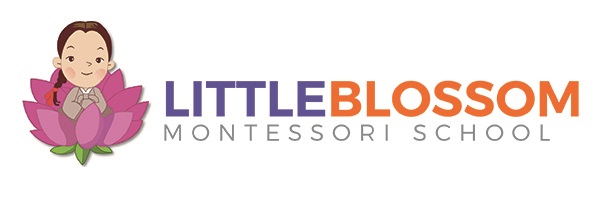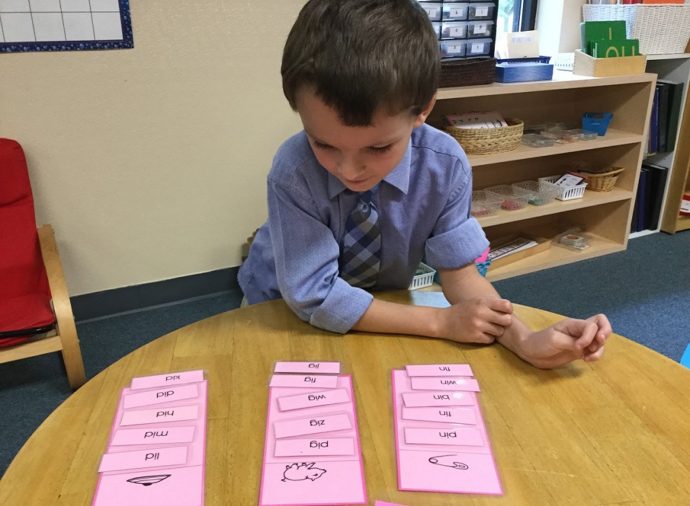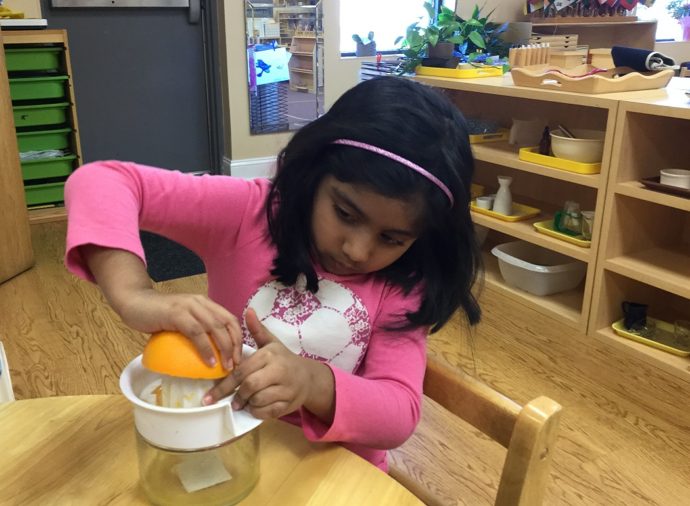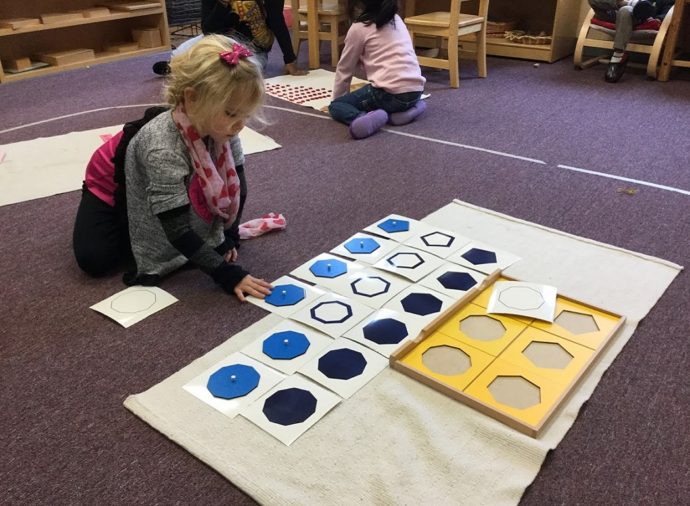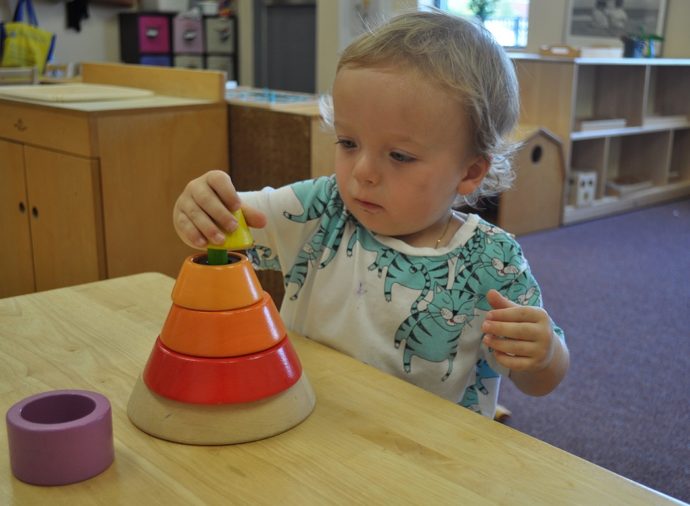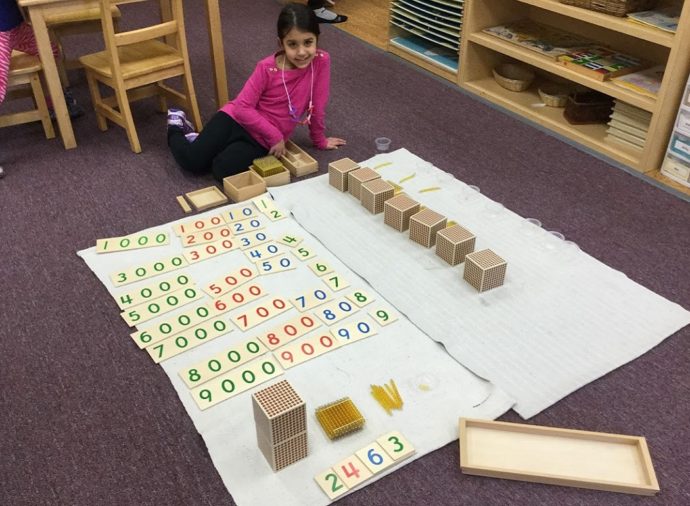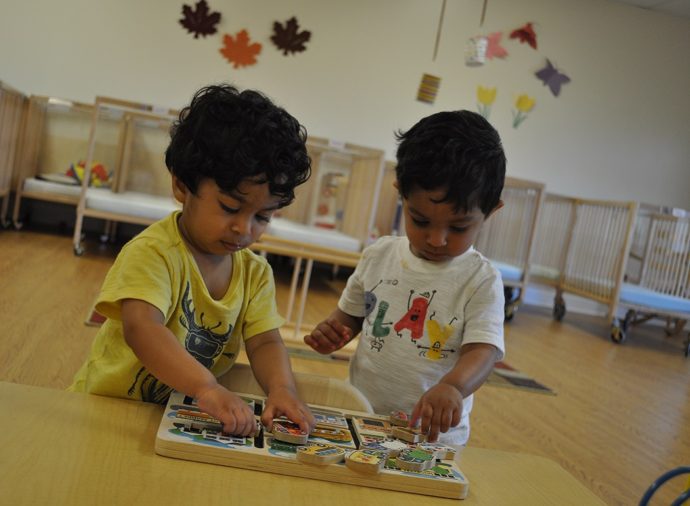-
Overview
We offer an interrelated curriculum focused on Practical Life, Language, Sensorial, Mathematics, Geography and Science.
-
We follow the revolutionary discoveries and educational approach of Dr. Maria Montessori, who started her first school 100 years ago.
-
Dr. Montessori’s educational legacy supports children in their natural development in all aspects including physical, social, emotional, spiritual and cognitive. Little Blossom Montessori is registered with the American Montessori Society (AMS) and licensed by the Illinois State Board of Education and DCFS.
-
We believe children learn best through structured activities, hands-on experiences and play in a nurturing and safe environment.
Our challenging curriculum helps children develop independence, concentration, a sense of order and self-discipline in a nurturing, supportive atmosphere based on individually-focused education and social development.
Little Blossom Montessori’s curriculum and facilities are designed to promote the benefits of self-discovery and self-confidence. Experienced Montessori trained faculty members use hands-on Montessori materials and a whole child approach.
Our preschool is guided by child-led development, allowing children to grow at their own unique pace and exposing them to art, cultural, geography, mathematics, reading, writing and science development.
-
-
Art
“Art is necessary to a child’s balance. A sense of beauty is about respect for others and thus of self-respect. Art is a medium to give children the desire to grow, dream, speak freely.” – Gérard Garouste.
The well-being of a child depends on his or her opportunities to discover, to experiment, to develop creativity, to seek and find new ways to use objects. A child who can react significantly to what it means to see, touch or feel more easily develops the capacity and desire to communicate with others. Artistic expression is one of a child’s most natural forms of expression. Through drawing, collage, painting, sculpture, puppet theater, dance, poetry, etc., children create, reveal themselves and express their needs.
Children’s paintings, for example, show what is pleasant and what is unpleasant in their relations with their own world and the world that surrounds them. To do so they combine their knowledge of things and their own unique relationship with them. As children grow, these relationships change, they become more aware of what surrounds them, and their emotional interests also change.
Any creative activity makes children more sensitive and helps them to be understanding. By creating, children exercise their right to feel free, without inhibitions and tensions, to develop their thoughts and feelings about themselves and those who surround them, to use the ability to think, perceive and feel in order to better understand others and to develop opportunities for cooperation and solidarity, and to enjoy their discovery of the world and recognize their own worth.
Cultural
“As a child, my generation wondered about the world… your children are going to be of the world… experiencing similarities and differences, wonder and appreciation, respect and hopefully working together.” – Maria Montessori
Geography is one of the oldest sciences. Dr. Montessori spoke of “giving the world to the child in this first plane of development.” The prepared environment, trusting adults, and the freedom to explore, give the child the world.
Geography comes from the children’s understanding of their world and their place in it. It comes through imaginative storytelling, accurate and descriptive language, sensorial rich experiences and beautifully made materials that allow for exploration and classifying experiences. Montessori preschools offer many opportunities for the child to expand knowledge of the world during the early years when they are motivated by spontaneous interest. The materials provided in the Geography area spark this interest. The sphere handled by the three-year- old discovers later to be the same shape as the globe of oceans and continents. Land and water forms can be filled with water to create a lake, an island, a peninsula, an isthmus, or strait. A ball of clay is rolled into a sphere, cut in half, and flattened into two circles that become hemispheres. Each continent on the puzzle maps is made up of parts that can be manipulated and put back together again, building a memory in the hands long before a memory in the words.
Children may choose a continent folder with pictures of people, places, food, clothing, children, work, housing, transportation, plants and animals. Conversations explode into questions and wonderment about the world with its similarities and differences. Children share family experiences, where grandma lives, where we have traveled or what is in the news.
Children realize that the flag they have been so carefully walking around the line with, represents the country of Azerbaijan, which they have no problem pronouncing, and as a matter of fact, the more difficult the name, the more fascinating to them. Exploring their world is exciting to them.
Animals of North America may be drawn and labeled in a report, a story, or a decorative border around a labeled map. As children learn to read, these materials are explored again through labeling and reading descriptions or definitions of these same geography materials.
The classroom offers children a concrete representation of history by letting them work timelines. Some examples of study through the use of timelines are: prehistoric life, presidents, the student’s own life timeline or the teacher’s life timeline and the child’s day. Other cultures as well as our own are explored and important figures from the past are discussed.
Foreign Language
Instruction in foreign languages has always been a focus of a well-rounded Montessori education. Our language program begins in the Pre Primary, ages 3 through 6, classrooms with fundamental vocabulary and develops more broad skills in students throughout the academic year. Pre- Primary students attend Spanish or French classes once a week.
Language
In Montessori classrooms, teachers incorporate both phonetic and whole-word strategies. To meet the needs of all children, teachers use a variety of strategies.
Language is an integral part of society. We use language to communicate and function individually, as well as together. A child’s introduction to language happens before birth. A newborn is capable of recognizing sounds. A child is born programmed to learn to communicate.
Dr. Maria Montessori discovered that during the first six years of life; children are particularly sensitive to learning language. Language can be learned after age six, but not as easily.
Language is spoken and it is heard, it is written as well as read. A child listens to us speak and eventually figures out how to use sounds that have meaning. A child sees writing and eventually figures out how to attach meaning to the squiggles and marks on a page. A little more work and the child can figure out how to produce marks and squiggles that others can understand. The materials in the Montessori classroom are considered “aids to the imagination”. The materials are designed to help the child develop the skills they need to learn. Basically, children teach themselves to read and write.
The language area contains many learning opportunities such as:
Learning the shapes and sounds of the letters
Perfecting the fine motor skills for writing
Vocabulary development
Matching of words and pictures
Reading silently
Reading development-reading word lists, sentences, stories
Parts of speech-word games with nouns, verbs and adjectivesThe development of language in an early-childhood classroom is an umbrella for the entire Montessori curriculum. Language learning occurs most profoundly in the moment-to-moment interactions within the classroom. Children learn to listen, speak, and later to write and read. Books, group activities, singing, finger plays, and sound games are some of the ways oral language is presented. A balanced environment, one that is open yet not chaotic or inappropriate, is the most conducive to language learning. Activities related to the development of early-literacy skills greet young children when they visit the language area of a Montessori classroom. These activities include opportunities for young children to expand vocabulary, listen carefully to common sounds, and look carefully to find likenesses and differences among objects and pictures. Matching sets of objects, learning the names of household tools, unusual fruits and vegetables and geometric shapes are other activities which build language and early literacy skills and will be found in a Montessori classroom. Dr. Maria Montessori personally developed only three language materials for the early childhood classroom: the metal insets, the sandpaper letters, and the movable alphabet. However, they have proven astoundingly effective. In fact, educators outside of Montessori have recognized the effectiveness of these materials and have created similar activities now being used in a variety of early-childhood settings.
In Montessori classrooms, teachers incorporate both phonetic and whole-word strategies. To meet the needs of all children, teachers use a variety of strategies.
Math
The entire purpose of Montessori Math is to make the abstract concrete, until the child can close her eyes and visualize mathematical processes at work. Step by step the materials become less concrete and symbolic.
Dr. Maria Montessori recognized the child’s attraction to stimuli and work when they researched and designed the math materials. The math materials are concrete and hands on. Their simplicity and elegance fascinate both the child and the adult. Each child is allowed to progress at his/her own pace. Learning mathematical concepts such as tall and short, more and less, and one to one correspondence (i.e. counting to 10) is presented with specially designed materials like towers, steps, and rods. Through repetition and presentation, children learn how to count and learn the corresponding written numeral and become familiar with the abstract concepts of addition, subtraction, division, multiplication as well as an understanding of geometry, measuring, weighing, and fractions.
Beginning with exercises of Practical Life and Sensorimotor, the child manipulates, explores, sequences, sorts, orders and repeats to construct her mathematical thinking. “We think of our sensorial material as a system of materialized abstractions, or of basic mathematics,” Dr. Maria Montessori explained. The child begins with the concrete and builds relationships, patterns and experiences until she/he moves into the abstract world.
There are eight identified skills which are important to building mathematical thinking. Observing, comparing, classifying and sorting, ordering and sequencing, joining and separating, measuring and estimating, and validating are the skills built through Practical Life and Sensory-motor exercises, which indirectly prepare the child’s mind.
“The entire purpose of Montessori Math is to make the abstract concrete, until the child can close her eyes and visualize mathematical processes at work. Step by step the materials become less concrete and symbolic.”
By exploring and examining concrete materials in the classroom, children build a foundation in concrete and abstract math.
-
Music
Everyone is born with a capacity for music. However, just as oral language, or other abilities, music cannot develop without experience.
Today, research indicates that more and more young adults are coming to adulthood uncomfortable with music. These young adults have not developed the basic skills to enable them to participate in, or enjoy, the benefits of the language of music.
At the same time, recent research confirms the importance of music. Research shows that music is a constructor of intelligence, a builder and organizer of the nervous system, as well as an expressive language of emotion and spirituality. In addition, it serves as a powerful socializer and form of recreation. Research also shows music’s role as a healer and maintainer of good health.
Everyone is born with a capacity for music. However, just as oral language, or other abilities, music cannot develop without experience. The inborn capacity for music cannot develop without proper nurturing. We are finding that we can no longer take development for granted. We must become consciously aware of what humans need to develop, and make provision for it. In no area is this more apparent than in music.
Perceptual Motor
Perceptual-motor refers to the way a person’s nerve pathways receive, organize, interpret, and respond to information received from the senses.
At Little Blossom Montessori the gross motor behaviors involved in active outdoor play with other children are related to children’s development of social skills and an understanding of social rules. Children spend their day enhancing their physical development especially gross motor development like balance, speed and strengths. Children also develop their fine motor development like hand-eye coordination. Children will also develop their team work skills and social interaction through a fun and harmonious play time.
Yoga
Through attending yoga children breathe deeply, move freely, live joyfully and enjoy their wonderful world. Attending one of our yoga classes kids move, stretch, breath deep, play games, and relax. Children will gain increased flexibility and strength; improve self-esteem, self-awareness and overall wellness. Once a week yoga classes give children the tools they need to learn how to relax and enjoy life.Ballet
Ballet is the foundation of all styles of dance and a must for any aspiring dancer! When a child is young, learning new things is easier for them. They can adapt and learn more quickly than when they are older. So, once a child begins in ballet at an early age, they are not only learning a valued art form but also getting trained for the life that is ahead of them. Students will learn the traditional form of dance that trains the body and the mind. They will develop flexibility, strength, control, coordination, line and musicality.Some of the benefits of ballet for young kids are:
They learn to follow instructions;
They gain a sense of discipline through learning new positions and steps;
They learn coordination, balance and how to control their bodies in motion;
They are active and getting exercise;
They become comfortable performing before groups.Practical Life
Education is not only simply a method for the imparting of a standard knowledge of correct behavior, but also for the provision of good habit. It helps the child to take cognizance of his human nature, and to furnish him with the elements of knowledge.
Education is not only a method to impart a standard of knowledge for correct behavior, but to also reinforce good habits. It helps the child to take cognizance of their human nature, and to furnish them with the elements of knowledge. Through education, the child will discover how to adapt to different societal situations. The Practical Life activities provide an ideal opportunity to practice and develop necessary skills. Practical Life is the foundation of education, therefore the purpose of the exercises are:
To help the child become independent.
To enable him to correlate his own physical, psychic and moral desires:
Physical desire to move and exercise growing limbs
Psychic – to perfect the movements
Moral – to become useful and helpful to others
To initiate in the child’s respect and love for any work.
To help the child to perform the activities of daily life with joy, skill, and grace through which he is attaining perfection.
To help the child on the road to faster normalization.
To develop and perfect muscle control and coordination.
To develop a sense of physical and mental order through accuracy in use of objects and working in specific sequence.
To develop understanding through control of the environment
In the Montessori classroom, the Practical Life Activities are the first activities the child is introduced to because they can immediately satisfy the child’s inner needs and desires. In this area, it allows children to do the things that adults do every day. Washing hands, dressing, and allows the child to take responsibility for his own appearance. Dusting, sweeping, and flower arranging allow the child to learn about his place in the environment, as well as develop large motor skills. Serving snacks and working together teach the child how to respect others and encourage the child to interact and respond to others. Practical life activities encourage children to develop self-awareness, self-discipline, will power, independence, confidence, coordination and a sense of responsibility. The practical life exercises provide two important links for a child. The first is between homes and then outside work because the exercises use many materials and tools that are found at home. The second link is between the child and nature. Also these environments are part of the curriculum patterns. It includes a threefold developmental purpose on the physical, psychic and intellectual development. It encourages self-respect and the growth of confidence, important to later learning through learning from the known to the unknown, the simple to complex.Science
Science is an integral element of the Montessori curriculum. The program is designed to cultivate the child’s curiosity and determination to discover the truth for themselves. They learn how to observe patiently, analyze and work through each problem.
Each child is a vibrant, curious person that has an inner drive to discover the world. The classroom has tremendous fascinating materials of science to choose from. Children learn through hands on experience, investigate and research. Students engage in field trips and hands-on experiments and typically respond with enthusiasm to the process of carefully measuring, gathering data, classifying and predicting the outcome.
One goal of Montessori science is to cultivate a lifelong interest in observing nature and discovering more about the world in which we live. Some science activities you could see in a Montessori classroom are activities of magnetism, weights, growing plants and classification of plants and animals. They also learn classification of Plant kingdom, Animal kingdom, Anatomy and Botany.
Source: Seldin, T., “Montessori’s Integrated Spiral Curriculum,” Tomorrow’s Child. 4:1, 5-11.
Sensorial
It is necessary to begin the education of senses in formative period, if we wish to perfect this sense development with the education which is to follow.
The Sensorial environment is important in a Montessori classroom because learning is reliant on the five senses. This bonded relationship between learning and the senses is relevant in the development of the forming child. The importance of the senses in relationship to the expansion of the mind is enriched through the sensorial environment.
“There is in a child a special kind of sensitivity which leads him to absorb everything about him, and it is this work of observing and absorbing that alone enables him to adapt himself to life” (Montessori, 1967, 62).
The sensorial materials help the child to become aware of detail. Each of the activities isolates one defining quality, such as color, weight, shape, texture, size, sound or smell. It is in this area that math concepts are first introduced and internalized.
The primary purpose of the sensorial activities is to help the child in his/her effort to sort out the many and varied impressions given by the senses. They help to do this in four ways:
They are specifically designed to develop order and to broaden and refine sense perception.
The activities identify a single quality which reveal a range of small differences in the quality and explore patterns in those differences.
The child’s understanding of the world is “broadened” when the sensorial activities awaken certain sense experiences that were previously unexplored, such as the feel of shapes or the smell of spices.
They allow the child to experience and concentrate on particular qualities in perfect clarity and isolation.The Sensorial environment is divided into the following six senses: Visual, Tactile, Stereognostic, Auditory, Olfactory, and Gustatory. The Visual materials aid in the child’s discernment of unique colors, shapes, and dimensions. The materials that represent the tactile portion consist of texture, density, baric, and thermic. Stereognistic materials represent the combination of touch and movement without visual assistance. “Two sensations, tactile and muscular, are mixed together, and give rise to that sense which psychologists call the ‘Stereo gnostic’ sense” (Montessori, 1985, 117). Auditory materials accentuate the distinction of unique sounds and tones. Olfactory materials address the difference between odors. Gustatory materials are geared to the taste buds and deciphering the contrast of flavors.
Thus, Montessori stated “it is necessary to begin the education of senses in formative period, if we wish to perfect this sense development with the education which is to follow. The education of the senses would be begun methodically in infancy, and should continue during the entire period of instruction which is to prepare the individual for life in society.”
The environment provides for the children an opportunity to explore all of their senses through individual activities that help to isolate, yet, still enhance all the senses.
-
Ready to Enroll Your Child?
